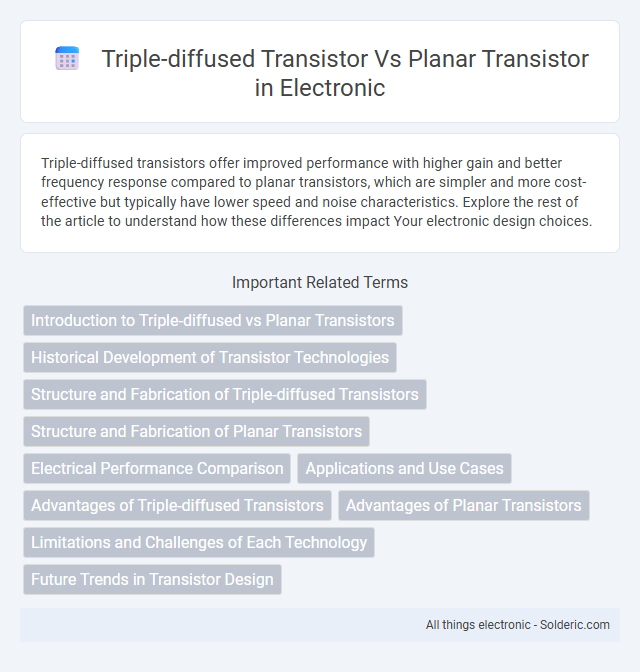Triple-diffused transistors offer improved performance with higher gain and better frequency response compared to planar transistors, which are simpler and more cost-effective but typically have lower speed and noise characteristics. Explore the rest of the article to understand how these differences impact Your electronic design choices.
Comparison Table
| Feature | Triple-Diffused Transistor (TRDT) | Planar Transistor |
|---|---|---|
| Structure | Three diffusion layers for emitter, base, and collector | Flat, surface-level diffusion with planar geometry |
| Fabrication Complexity | Higher due to multiple diffusion steps | Lower, simpler planar processing technology |
| Performance | Improved current gain and switching speed | Good performance with ease of integration |
| Size | Generally larger due to layered diffusion | Compact, suitable for VLSI integration |
| Applications | High-power and high-frequency devices | Standard ICs, logic and analog circuits |
| Thermal Stability | Better heat dissipation due to structure | Moderate thermal characteristics |
| Noise Performance | Lower noise due to precise diffusion layers | Higher noise compared to TRDT |
Introduction to Triple-diffused vs Planar Transistors
Triple-diffused transistors feature three distinct diffusion regions enhancing current gain and switching speed compared to traditional planar transistors, which rely on a single diffusion layer. The triple-diffusion process improves the transistor's ability to handle higher currents and voltages, making them ideal for power applications. Your choice between triple-diffused and planar transistors depends on the specific performance requirements and thermal management needs of your electronic design.
Historical Development of Transistor Technologies
The historical development of transistor technologies began with planar transistors introduced in the late 1950s, revolutionizing semiconductor fabrication through the use of surface diffusion and oxide masking, which improved production yield and device reliability. Triple-diffused transistors, developed in the 1960s, emerged as an advancement by incorporating an additional diffusion step to create complex junctions, enhancing transistor performance and enabling higher-frequency applications. Your choice between these technologies depends on the required electrical characteristics and manufacturing considerations influenced by their distinct evolutionary paths.
Structure and Fabrication of Triple-diffused Transistors
Triple-diffused transistors feature a complex structure created by sequentially diffusing three dopant layers, enhancing control over the base and emitter regions, which improves switching speed and reduces leakage current compared to planar transistors. The fabrication process involves multiple ion implantation or diffusion steps, precisely shaping the transistor's junctions to optimize electrical characteristics and thermal stability in high-power applications. Your choice of triple-diffused transistors provides superior performance in power electronics due to this advanced doping profile and robust construction.
Structure and Fabrication of Planar Transistors
Planar transistors feature a flat semiconductor surface with source and drain regions diffused laterally into the substrate, enabling precise control over device characteristics through photolithography. Their fabrication involves steps like oxidation, photolithographic patterning, ion implantation or diffusion doping, and metallization, which collectively ensure uniform junction depths and planar surfaces ideal for integrated circuit scaling. You benefit from planar transistor technology due to its compatibility with large-scale manufacturing processes, resulting in reliable, cost-effective semiconductor devices.
Electrical Performance Comparison
Triple-diffused transistors exhibit superior electrical performance compared to planar transistors, featuring lower saturation voltage (V_CE(sat)) and higher current gain (h_FE) due to their optimized doping profile. The multi-layer diffusion in triple-diffused transistors reduces base resistance and enhances carrier injection efficiency, leading to faster switching speeds and improved frequency response. In contrast, planar transistors typically have higher parasitic capacitances and lower gain, resulting in reduced efficiency for high-frequency and high-power applications.
Applications and Use Cases
Triple-diffused transistors excel in high-frequency and high-power applications such as RF amplifiers and switching circuits due to their enhanced gain and breakdown voltage characteristics. Planar transistors, favored for integrated circuits and mass production, provide reliable performance in low-power and digital applications like microprocessors and memory devices. Your choice depends on whether the priority is on power handling and frequency response or on integration density and manufacturing scalability.
Advantages of Triple-diffused Transistors
Triple-diffused transistors offer superior performance in high-frequency and high-power applications due to their enhanced current gain and reduced base resistance compared to planar transistors. Their three-diffusion fabrication process enables precise control of doping profiles, resulting in improved switching speed and thermal stability. This leads to greater efficiency and reliability in power amplification and switching circuits.
Advantages of Planar Transistors
Planar transistors offer superior scalability and ease of integration in modern semiconductor fabrication processes compared to triple-diffused transistors. Their planar structure allows for reduced parasitic capacitance and improved high-frequency performance, crucial for advanced integrated circuits. Enhanced thermal stability and lower manufacturing complexity further contribute to the widespread adoption of planar transistors in modern microelectronics.
Limitations and Challenges of Each Technology
Triple-diffused transistors face limitations in scaling due to higher parasitic capacitances and increased manufacturing complexity, which can impact switching speeds and yield rates. Planar transistors encounter challenges with short-channel effects and leakage currents as device dimensions shrink, limiting their performance in advanced technology nodes. Both technologies require innovative materials and design approaches to overcome these scaling and power efficiency constraints.
Future Trends in Transistor Design
Triple-diffused transistors offer enhanced high-frequency performance and greater thermal stability compared to planar transistors, making them a focus for future RF and power amplification applications. Future trends in transistor design emphasize integrating triple-diffused structures with advanced semiconductor materials like GaN and SiC to push device speed and efficiency boundaries. Research also targets scaling down dimensions while maintaining robustness, leveraging triple-diffused techniques to overcome short-channel effects prevalent in planar transistor architectures.
Triple-diffused transistor vs Planar transistor Infographic

 solderic.com
solderic.com